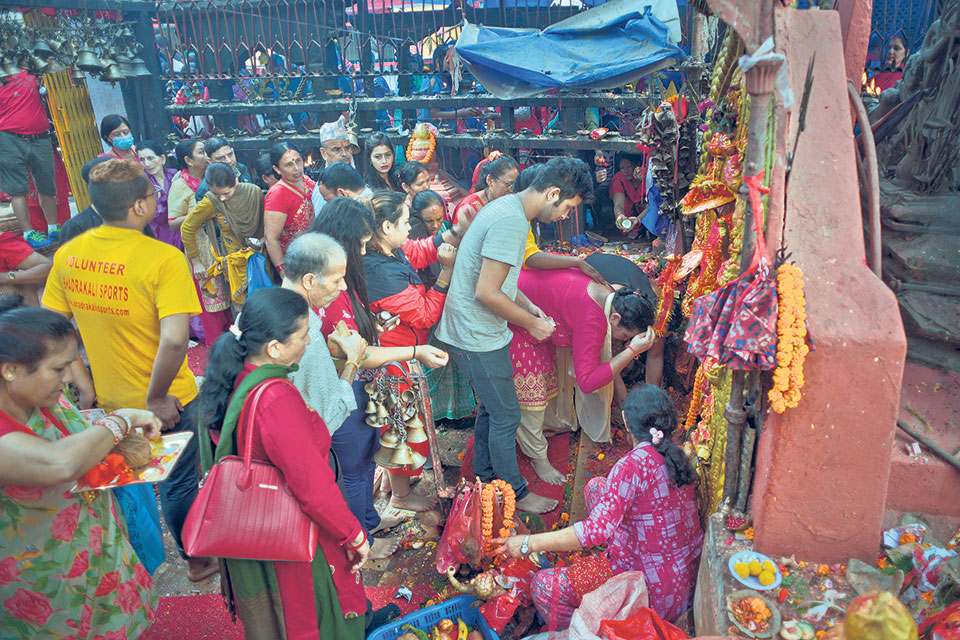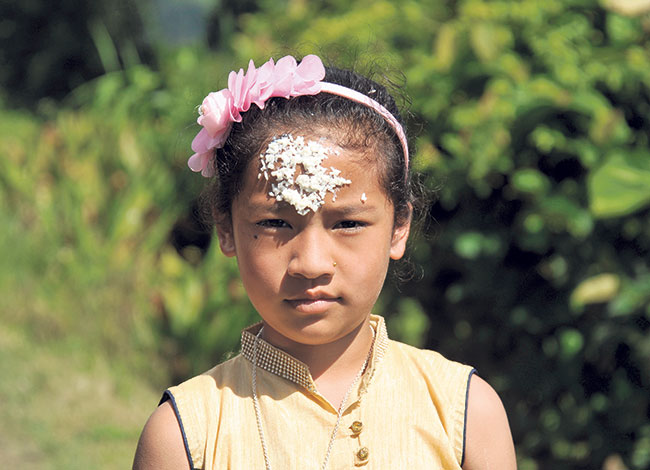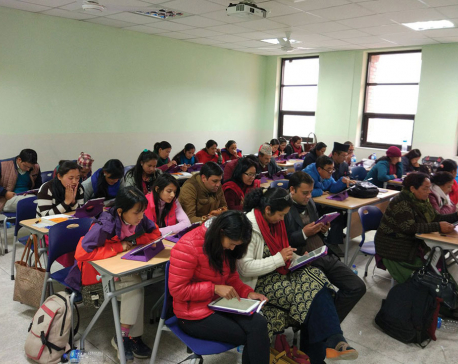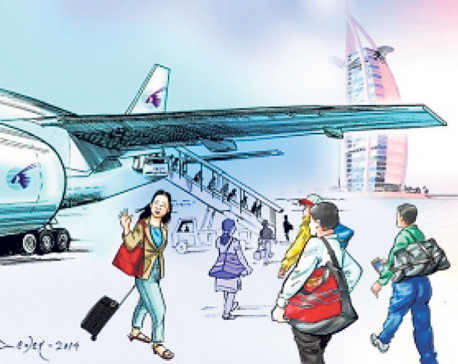
OR

Sanskriti Rijal, a school student, went on a Annapurna Base Camp trek during the recent Dashain holidays. She says her parents didn’t object as this is the only long holiday she gets at her school and she wanted to ulitize it properly, and not by carrying out rituals she barely even understands.
 Santoshi Shakya who recalls waking up at three in the morning to be at the temple near her home by four during all the nine days of Dashain laments the fact that the very meaning of festivals seem to be changing. “We used to enjoy the smell and sounds of different temples and would collect fresh flowers to make offerings to Goddess Durga,” says Shakya recollecting her childhood memories.
Santoshi Shakya who recalls waking up at three in the morning to be at the temple near her home by four during all the nine days of Dashain laments the fact that the very meaning of festivals seem to be changing. “We used to enjoy the smell and sounds of different temples and would collect fresh flowers to make offerings to Goddess Durga,” says Shakya recollecting her childhood memories.
However, Shakya’s own children were not interested in temple visits during Dashain recently. “The new generation doesn’t seem to value these things anymore,” she explains.
Nowadays, Dashain is all about having fun, coming together of families and spending time with your loved ones. However, just a few decades ago this festive celebration was attached to much more religious and ethical values.
“Dashain used to be the time of collective gathering and collective prayers. It was a festival of unity, purity, and auspiciousness. Now temple visits have become more of a trend,” says 75-year-old Kishore Kumar. “Earlier temples were kept clean. You could walk bare feet and not be bothered.
Now you’ll feel the grime under your feet. I have started to believe that it is all just a show where people go to the temple, dirty the place, click pictures and come back home,” he adds claiming that the entire purpose of the festival is lost.
According to the Hindu mythology, the nine days of Dashain symbolizes the battle between Durga and Mahishasura who created terror in Devaloka a place where Gods lived. On the tenth day it is said that Mahishasura was defeated by Durga. According to the epic Ramayana, this day is also celebrated as the day when Rama defeated Ravana.
However, most youth this scribe spoke to seemed disinterested in these mythologies. “We are more concerned about having fun and making the most of our holidays,” says Kiran Bhattarai who was out with his friends in Civil Mall, Sundhara. “I’m unaware of the reasons behind Dashain celebrations. We get together, have different delicacies and enjoy our time away from work and studies,” added another friend from the same group.
While some youngsters like hanging out with their friends, there are some who utilize this holiday by spending time with their families. “I make sure I spend time with my family during this time of the year,’ says Nikesh Mudbhari who recently came to Kathmandu from Thailand where he is pursuing a masters degree in business. “Dashain for me is just an excuse to have a good time back home,” he adds.
With thousands of people migrating abroad in search of a better lifestyle, homes back in Nepal have become almost empty. “We celebrate major festivals such as Dashain and Tihar through Skype with our children,” says Nanu Pathak, a social worker. “At times when our children get too busy, they don’t even have time to come online on Skype,” she exclaims sadly.
For many living abroad Dashain seems to have lost its charm. “We hardly get any holidays from office. Even our children are busy with their schools and colleges. We are trying to preserve our culture but the joy of celebrating Dashain in Nepal cannot be replicated anywhere else,” says Shaligram Tiwari who is currently working in Mumbai, India.
With social media filled with posts of Dashain celebration, it seems as if the festival can never lose its charm. But the reality might be a bit different. “Previously people went to their elders to get blessings during Dashain. Now, the main purpose of putting Tika is to display those pictures on social media. People pose for a photo as they put on tika, sometimes even repeating the act to get a good shot,” says songwriter Kalpana Adhikari.
“Dashian also seems to be all about taking selfies and clicking pictures of your food and posting them online. It was sad to see so many children constantly engaged in their phones, iPads and tablets during Dashain. They did not enjoy the festival or the company of their relatives. Apparently, virtual happiness is more important in today’s world,” adds Pathak.
Nirmal Rijal, who was going to his relative’s place to get their blessings during the final days of Dashain, recollects fond memories of Dashain when kites and swings were an inseparable part of the festival. “Children these days are tethered to their gadgets. Practice of flying kites during Dashain has waned. Like most other Hindu festival, Dashain too has become an occasion of merry-making. The significance of the festival is getting lost,” he says.
Traditional Nepali food is also rarely cooked at home these days. This festive season saw more people going to restaurants and enjoying their time with a closed knit group. “Dashain has been brought down to where you can afford to eat and what you wear.
The cultural and religious importance are almost lost now,” says Laxmi Pandey, a homemaker who feels that along with enjoyment children should also be taught the importance of preserving our culture and tradition.
While on one hand many were dissatisfied with the changes in Dashain celebration, most youth feel that our cultures are transforming and evolving for the better. “Have you ever thought of a menstruating girl during Dashain?” questions Kshitiz Karki, a post graduate student at Tribhuwan University. “She is not allowed to celebrate this auspicious festival because she is considered impure. So in order to break these norms, I celebrated Dashain this year even when I was menstruating,” she adds proudly.
“Many people say that our kitchens have changed too and that traditional delicacies aren’t made anymore during Dashain. These days, women too are more into travelling, relaxing and taking a break from everyday life. The orthodox idea of women being confined to the kitchen to cook delicacies for men is changing. And it has to change,” says 24-year-old Avas Parajuli adding that changes in tradition are not always for the worse.
However, many people this scribe spoke to also confessed that immediately after the official Dashain holidays were over, they started looking forward to Tihar holidays. Again, as with Dashain, it wasn’t the tradition or culture of the festival that they seemed to be anticipating, rather it was the lure of another extended holiday they could spend any way they liked, preferably meeting up with friends or going on a mini vacation.
“The very idea of our festivals are slowly changing, and given how fast paced and ambitious life has become these days where we work without a break the rest of the year, I don’t think there is much we can do to reverse that,” concludes banker Pranita Thapa who went on a trip to Malaysia this Dashain.
You May Like This

Transforming learning process through u-learning in community schools
BANEPA, Aug 5: Ubiquitous learning or u-learning; is not yet a much heard term in the country. However, this ‘portable’... Read More...

Transforming the society
The urgent need of the hour is to transform the current culture of Nepali society from an unstable “lahure” to something... Read More...

Transforming Lives
For most tourists and expats, Nepal appears to be a beautiful Shangri-La with delicious food, friendly people, heavenly places, and... Read More...




_20220508065243.jpg)
Just In
- MoHP cautions docs working in govt hospitals not to work in private ones
- Over 400,000 tourists visited Mustang by road last year
- 19 hydropower projects to be showcased at investment summit
- Global oil and gold prices surge as Israel retaliates against Iran
- Sajha Yatayat cancels CEO appointment process for lack of candidates
- Govt padlocks Nepal Scouts’ property illegally occupied by NC lawmaker Deepak Khadka
- FWEAN meets with President Paudel to solicit support for women entrepreneurship
- Koshi provincial assembly passes resolution motion calling for special session by majority votes













Leave A Comment